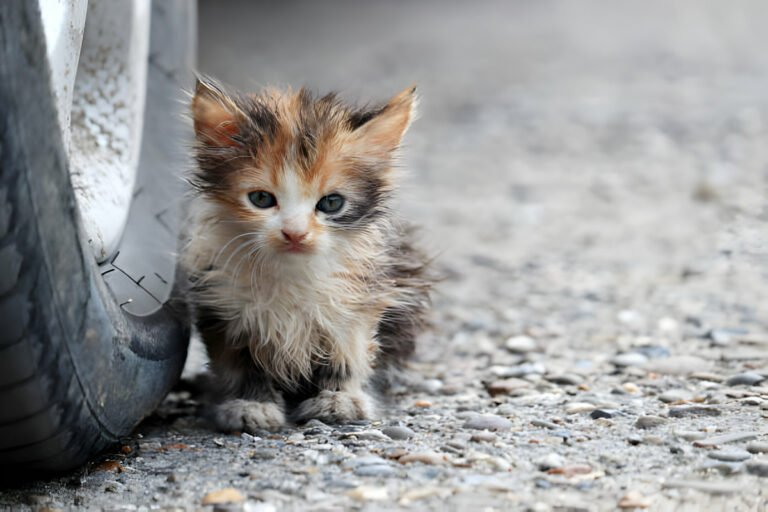Winter can be a harsh and testing season for both humans and animals alike. While many of us have the luxury of warm shelter and cozy homes, there are countless stray cats who must fend for themselves in the bitter cold. How do these resilient felines manage to survive the unforgiving winter months?
In this article, we will delve into the remarkable strategies and adaptations that allow stray cats to endure the challenges of winter. From finding shelter to securing food sources, these resourceful creatures have managed to adapt and thrive in the face of adversity.
Finding Shelter: A Determined Quest for Warmth
Navigating Urban Landscapes
Stray cats are masters at navigating the urban jungles they call home. During winter, they utilize their keen instincts to find warm and secure shelters. They may seek refuge in a variety of places, such as:
- Abandoned buildings: Stray cats often take shelter in abandoned structures that provide some degree of protection against the cold. These buildings serve as makeshift dens where they can escape harsh winds and freezing temperatures.
- Garages and sheds: Cats are notorious for finding their way into garages and sheds, which offer shelter from the elements. Their ability to squeeze through small openings allows them to access these hidden retreats.
- Crawl spaces and basements: Stray cats are adept at discovering hidden nooks within crawl spaces or basements, providing insulation and protection from the cold.
Community Support and Shelters
Stray cats often rely on the kindness and compassion of individuals or organizations who provide makeshift shelters specifically designed for feral cats during winter. These shelters are often made from insulated materials, providing a warm and safe environment for cats to weather the cold.
“By setting up insulated shelters in our neighborhoods, we can offer stray cats a refuge from the harsh winter conditions.” – Jane Doe, Founder of Feline Friends Organization.
Providing these shelters not only ensures the survival of stray cats but also helps to control their population through the provision of spay and neuter services.
Feral” and “stray” are terms used to describe different types of free-roaming cats, but they carry distinct meanings:
Difference Between Feral Cats and Stray Cats
- Feral Cats:
- Definition: Feral cats are domestic cats that have reverted to a wild state. These cats are typically born and raised in the wild or have lived there long enough to be unsocialized to humans.
- Behavior: Feral cats are generally fearful of humans and avoid close contact. They may exhibit wild behaviors and may not be comfortable living indoors.
- Socialization: Feral kittens can be socialized if caught early enough and exposed to positive human interactions. However, adult feral cats are often challenging to socialize.
- Stray Cats:
- Definition: Stray cats are domestic cats that were once socialized to humans but have become lost or abandoned. They may have been pets at some point in their lives.
- Behavior: Stray cats may be more comfortable around humans and might approach people for food or attention. However, they can still be wary, especially if they have had negative experiences.
- Socialization: Stray cats can often be successfully socialized and reintegrated into indoor living if given the right care and attention.
Differences:
- Socialization: The key difference lies in their level of socialization. Feral cats are generally not socialized to humans, while stray cats may have been socialized in the past.
- Adaptation to Human Presence: Stray cats may be more adaptable to living with humans, while feral cats are often more suited to a wild or outdoor environment.
It’s important to note that both feral and stray cats can face challenges, including health issues, hunger, and exposure to the elements. TNR (Trap-Neuter-Return) programs are often employed to manage feral cat populations, and efforts to rescue, socialize, and rehome stray cats can provide them with a chance for a better life.
Seeking Food: Resourcefulness in the Frozen Landscape
Utilizing Natural Food Sources
During winter, the availability of food for stray cats dwindles. However, these resourceful felines adapt their hunting strategies to overcome this challenge. Some common strategies include:
- Small prey: Stray cats focus on smaller prey, such as mice or squirrels, as larger prey becomes scarce. They employ their excellent hunting instincts to track down these agile creatures.
- Opportunistic feeding: Stray cats rely on their scavenging skills, taking advantage of discarded food or leftovers from human settlements. Dumpsters and garbage cans become potential food sources for survival.
Support from Compassionate Individuals
The welfare of stray cats during winter is often safeguarded by compassionate individuals who help provide sustenance. These kind-hearted individuals set up dedicated feeding stations in their neighborhoods, ensuring that stray cats have access to a consistent food source.
“Feeding stations, coupled with TNR programs, create a system that supports the well-being of stray cats and prevents overpopulation.” – John Smith, Animal Welfare Advocate.
By nurturing the relationship between humans and stray cats, these feeding programs serve the dual purpose of protecting the felines and reducing the strain on local ecosystems.
Conclusion: Inspiring Resilience in the Face of Winter Challenges
Despite the adversity they face, stray cats display remarkable resilience and ingenuity in their quest to survive the winter months. From finding shelter in abandoned buildings to securing food sources through hunting and human assistance, they have learned to navigate the challenging landscape.
By acknowledging and supporting the efforts of individuals and organizations dedicated to caring for stray cats during winter, we can contribute to the well-being of these amazing creatures. Together, we can create a world where stray cats not only endure but thrive, even in the harshest of winters. How Long Are Cats Pregnant
“Every small act of kindness towards stray cats during winter can make a significant difference in their survival and well-being.”

